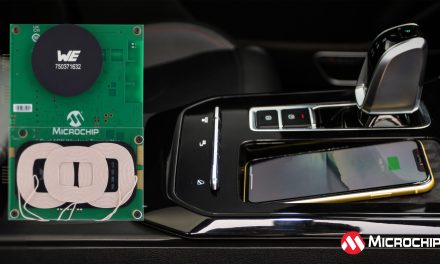 Advertisement feature
Advertisement feature
Richard Ying Design Engineer & Willie Chan Senior Product Marketing Engineer at Linear Technology Corporation discuss key specifications to consider when designing power modules into an application, to ensure the design and end device remain fully compliant with government standards
As a result of market demand for increased performance in information technology and communications equipment, today’s system designers face a big challenge of designing EMI-compliant products.
 Prior to sale, all information technology equipment (ITE) commonly defined as having a regulated clock signal greater than 9kHz must meet government standards such as FCC Part 15 Subpart B in the United States and EN55022 in the European Union, which define maximum allowable radiated emission for industrial and commercial environments (Class A) and home environments (Class B).
Prior to sale, all information technology equipment (ITE) commonly defined as having a regulated clock signal greater than 9kHz must meet government standards such as FCC Part 15 Subpart B in the United States and EN55022 in the European Union, which define maximum allowable radiated emission for industrial and commercial environments (Class A) and home environments (Class B).
Such strict EMI standards, engineering manpower constraints and fast time to market demands have increased the popularity of EN55022-certified power modules. However, it is important to be aware of the electrical operating conditions  under which the power module was certified to avoid surprises later in the design.
under which the power module was certified to avoid surprises later in the design.
An understanding of EMI sources and field strength factors in switch mode regulators will help the design engineer select the best components to mitigate electromagnetic emissions particularly in leading-edge equipment, which require ever-higher current levels.
 EMI radiation sources
EMI radiation sources
By their very nature, switching power supplies generate electromagnetic waves that radiate into the surrounding atmosphere. The pulsating voltages and currents associated with the switching action generate and directly influence the strength of radiated electromagnetic waves (see side bar). Furthermore, parasitic devices within the converter also contribute to electromagnetic radiation. Figure 2 presents a typical step-down converter including parasitic inductors and parasitic capacitors of the power MOSFETs used.
 During each switching cycle, the energy stored in the parasitic inductor will resonate with the energy stored in the parasitic capacitor. When the energy is released a large voltage spike is created at the switch node (VSW), which can be as large as twice of the input voltage, as shown in Figure 3.
During each switching cycle, the energy stored in the parasitic inductor will resonate with the energy stored in the parasitic capacitor. When the energy is released a large voltage spike is created at the switch node (VSW), which can be as large as twice of the input voltage, as shown in Figure 3.
As the current capability of the MOSFET increases the energy stored in the parasitic capacitor tends to increase as well. Switching action also pulses the input current and the current flowing through both top MOSFET (ITOP) and bottom MOSFET (IBOT).
This pulsating current generates electrical waves on the input supply cable and on the PCB board traces, which act as a transmitting antenna generating both radiated and conducted emissions.
 As input voltage and output current increase, so will the magnitude of the voltage spike at the switching node as the power inductor changes polarity during each cycle. Moreover, the higher the output current, the larger the pulsating current generated inside the circuit loop. So radiated emission is highly dependent on the electrical operating conditions of the device under test.
As input voltage and output current increase, so will the magnitude of the voltage spike at the switching node as the power inductor changes polarity during each cycle. Moreover, the higher the output current, the larger the pulsating current generated inside the circuit loop. So radiated emission is highly dependent on the electrical operating conditions of the device under test.
In general, radiated noise increases with higher input voltage and higher output power, particularly output current. Design engineers are forced to overcome these challenges. As the low noise alternative, linear regulators are too inefficient and dissipate too much heat at the high voltages and high- power levels enabled by state of the art switching power solutions where EMI mitigation becomes challenging.
Alternative methods to reduce the radiated EMI from a switch mode power converter design face other challenges. One conventional method is to add an EMI shield surrounding the power solution, which will contain the EMI field within the metal enclosure. However, an EMI shield adds design complexity, size and cost.
|
EMI Radiation & Electromagnetic Theory A reflection on electromagnetic theory will give a better understanding of the EMI implications of high-power step-down converters operating at ever-higher voltages and higher output power. Recall Gauss’ Law, which states that the strength of an electric field in a given area over an enclosed volume is proportional to the total charge inside it.
That charge is proportional to the amount of current passing through a PCB trace, for example. (One ampere equals 1 coulomb of charge per second.) Therefore higher currents required for increased output power create stronger electric fields, which are of course constantly changing in a switch mode regulator as alternating current paths are active at different times within a cycle. Maxwell’s equations then tell us this constantly varying electric field creates a proportionally stronger magnetic field resulting in a self sustaining EMI wave radiating from the conductor, all the current paths within step-down regulator. The discussion presented here is by no means complete, for example the implications of the magnetic component surrounding the current paths and the rapid voltage polarity changes on the power inductor have yet to be discussed however, the impact of higher output power on radiated EMI is particularly clear. |
An RC snubber circuit at the switching node (VSW) could help to reduce the voltage spike and subsequent ringing. However, adding an RC snubber circuit will reduce operating efficiency thereby increasing power dissipation, which results in higher ambient and PCB temperatures.
The last strategy involves a good PCB layout including local low ESR ceramic decoupling capacitors with short PCB trace distances for all high- current paths, to minimise the parasitics, shown in Figure 2, at the cost of additional engineering design time and a longer time to market.
Overall, a lot of power design experience and tough tradeoffs are required of an engineer to meet size, efficiency, heat and EMI specifications together, especially in high-input voltage, high-output power applications for the reasons explained.
Often a huge amount of time and energy is required for a circuit designer to evaluate the tradeoffs and design an EMI compliant power converter, which meets all the needs of the system.
EMI compliance
To guarantee a simple EMI compliant high-output power supply design, Linear Technology developed the LTM4613 8A step-down µModule
regulator demo board (DC1743) and presented it to an independent certified test laboratory, TUV Rheinland whose 10 meter EN55022 test chamber is accredited by the U.S. National Institute of Standards and Technology (NIST).
Under a 24V input delivering 96W of output power, the demo board was found to be compliant with EN55022 Class B limits. With only input capacitance, output capacitance, and a few other small components required, a worry-free EN55022B compliant solution is easy to achieve particularly with Gerber files freely available online.
The LTM4613 delivers the highest output power and efficiency among all proven EN55022B compliant power module products on the market. With a carefully designed integrated filter, meticulous internal layout, shielded inductor, internal snubber circuitry and power transistor driver, the power module has already achieved a perfect balance between size, output power, efficiency and EMI emissions.
This device along with many other members of the EN55022B certified µModule regulator family with various output power levels eliminate the need for magnetic shields and external snubbers reducing overall solution size, cost, and design effort.
Designing an information technology equipment (ITE) product for EMI compliance is a necessary requirement, which requires great skill and time. While cumbersome, such limits are critical to guaranteeing proper functionality of neighbouring electronic equipment or other sub components within the system itself.
To address this need, EN55022 Class B certified power modules such as the LTM4613 have been introduced. However, since EMI field strength is highly dependent on multiple factors such as the input voltage, output current, output voltage and PCB layout, when comparing products be certain the EN55022 certification was performed under similar electrical conditions at an input voltage and output power-level similar to your design within an industry approved EMI test facility.
Publication of EMI test result
Linear Technology has made public the EMI test results for the most popular operating conditions and demo board Gerber files giving customers a known good power supply design certified by an authorised independent laboratory for your peace of mind.
Linear Technology




